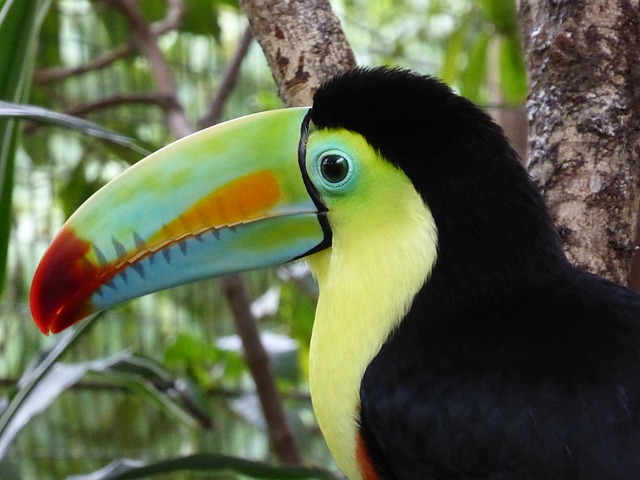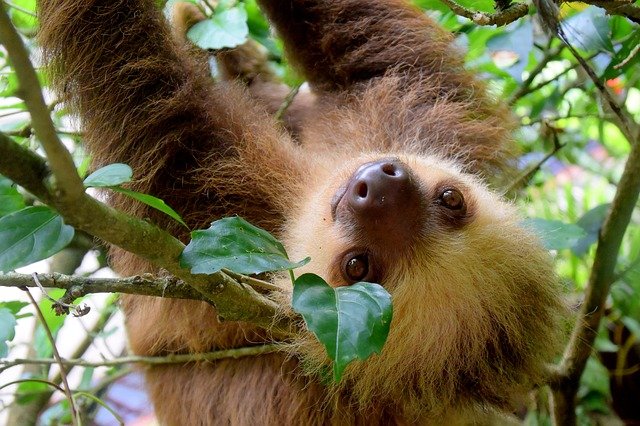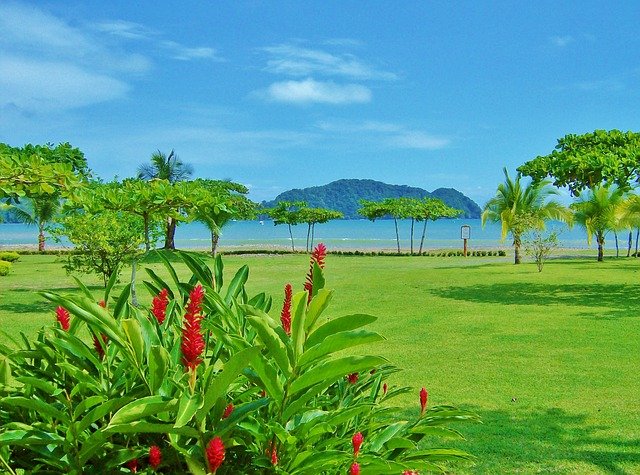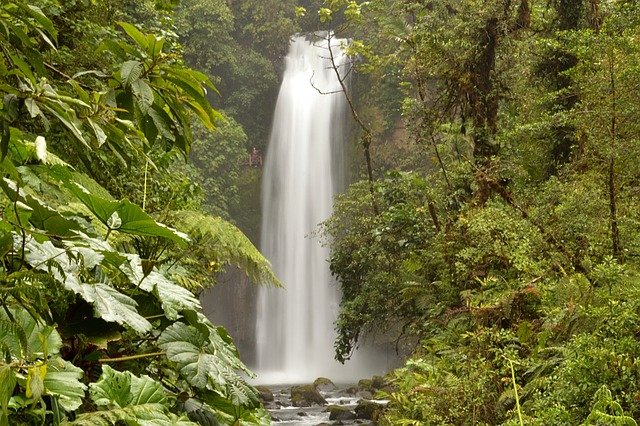Why book this trip?For a tiny country, Costa Rica packs a huge wildlife punch. Containing 5% of the world’s biodiversity, its thick forests teem with life, from brightly coloured toucans to slow-moving sloths. With adventure and beautiful beaches to boot, this two-week trip won’t disappoint. - – Tortuguero– Cruise the jungle waterways and explore the rainforest of this ‘mini Amazon’
- – Adventure– Included white water raft on the Pacuare river, or opt to fly through the canopy on a zip wire
- – Manuel Antonio– Share the stunning white-sand beaches with sun-bathing iguanas and capuchin monkeys
INCLUDED MEALSBreakfast: 14 Lunch: 4 Dinner: 3 TRIP STAFFExplore Tour Leader / Driver Boat Crew TRANSPORTBus Boat ACCOMMODATION5 nights comfortable hotel 3 nights premium hotel 6 nights comfortable lodge Itinerary- DAY 1– Join trip in San Jose
Arrive in San Jose. The cosmopolitan Costa Rican capital lies in a fertile valley at an altitude of 1150 metres. Coffee and sugar cane are big industries here and coffee is even planted between new buildings and along the roadside on the outskirts of the city. For those arriving on time our Leader plans to meet you in the hotel reception at 7pm for the welcome meeting, and for those that wish there is the chance to go out for dinner. There are no other activities planned today, so you are free to arrive in San Jose at any time. If you would like to receive a complimentary airport transfer today, you’ll need to arrive into San Jose’s Juan Santamaria International Airport (airport code SJO) which is 18km, around thirty minutes from our hotel. Should you miss the welcome meeting, your Leader will inform you of any essential information as soon as you catch up. If your flight arrives earlier in the day, perhaps you might choose head out to explore the city which is easy to navigate with a grid pattern of avenues and streets with a good choice of local eateries, which you may choose to sample this evening. The National museum (Museo Nacional De Costa Rica) is also well worth a visit.
- DAY 2– Visit the Poas Volcano; try out traditional oxcart painting
This morning, an hour’s drive will take us to the Poas Volcano National Park, where the smoke from one of Costa Rica’s most active volcanos rises majestically from the tropical rainforest. At almost a mile in diameter, the main crater is one of the largest in the world. Due to recent volcanic activity, time at the crater viewpoint is restricted to 20 minutes. If activity increases again the authorities may choose to close the park, and in that case you’ll visit the Doka coffee estate, including a tasting session of Costa Rica’s finest export. After our visit to Poas, we’ll continue onto the town of Sarchi, well known throughout Costa Rica for its beautiful and intricate arts and crafts. It is famous for producing colourful and decorative oxcarts, which are a huge part of Costa Rican culture today, and even considered one of Costa Rica’s national symbols. We\ re going to meet one of the town’s hard-working artisans and learn to paint a traditional oxcart with some of the patterns and designs familiar to the area. In the late afternoon we return to San Jose – you may like to take a taxi out to the gastronomic area around the Barrio Escalante, where craft beer pubs and quirky restaurants are a growing trend.
- DAY 3– Drive to San Gerardo de Dota and the Savegre Cloud Forest
This morning we drive south out of San Jose, down to the wild cloud forest of Savegre, famously one of the best places in Costa Rica for sightings of the elusive Resplendent Quetzal. The peace of the region is an outstanding introduction to Costa Rica’s natural beauty. Hikers will enjoy the forest trails and the journey through the alpine-like hills, while nature lovers visit for its biodiversity – the area around San Gerardo de Dota contains around 200 species of bird and countless plant types including various orchid species. This afternoon we explore the trails around our lodge, perhaps crossing the path of the river that runs through the lodge, as we delve into the surrounding cloud forest.
- DAY 4– Early morning search for quetzal; free day to explore the forest
We have an early start to get out into the trails surrounding our lodge this morning, in the search for the quetzal. The males of the species are vivid, with a red breast, green crest and the iconic long green tail that dangles from the branches. Despite the bright colours, they are very effective at camouflage and are surprisingly difficult to pick out among the greens of the trees. Binoculars are a useful addition to your kit here, as our Leader will be diligently attempting to find us one of these famous birds. After returning to the lodge for breakfast, we have the rest of the day free to spend as we wish. There are enough walks and trails around the lodge to spend a day here easily. The forest is rich in flora and fauna, and the mountainous cloudforest landscapes are perfect for keen photographers to make the most of.
- DAY 5– Travel to rural Turrialba; free afternoon and evening meal at a traditional finca (farm)
The fertile land around Turrialba makes it an important agricultural region for coffee, sugar and Macadamia nuts, as well as dairy production, with its cheese being famous throughout the country. Our journey takes approximately three hours, and we’ll arrive in the afternoon leaving us at our leisure to explore the area. You may choose to visit CATIE (Centro Agronomico Tropical de Investigacion y Ensenanza) Research Centre. Recognised throughout the world as an important agronomic station, its environmental development projects seek to protect natural resources. The botanic garden is a special place to relax, surrounded by the calls of birds, the whisper of the giant Guanacaste tree and the imposing Ceiba. This evening, we will be visiting a typical ‘finca’ (farm), for a traditional meal – the local cheese will certainly be on the menu!
- DAY 6– Whitewater rafting through the forest-covered Pacuare River
One of Costa Rica’s most scenic rivers, the Pacuare is a perfect place for both rafting aficionados and enthusiastic newcomers. Calm stretches between the class III-IV rapids allow time to appreciate the passage through rainforest-topped canyons and tumbling waterfalls. Macaws and blue morpho butterflies wheel past as we raft through the steep, green walls of the canyon. The first section of the canyon is mainly II-III rapids, giving us chance to test the skills that our experienced rafting guides will teach us, gaining confidence as we go. We then move into the III-IV rapids. You don’t need previous rafting experience, as our guides will give us all the knowledge necessary. This river is not difficult to raft, but provides a lot of rapids in a short stretch of water, giving us the perfect mix of adventure and fun. It can be rafted year-round, but is of course subject to weather and river conditions. If the water levels on the Pacuare are low, there is another section of the river called ‘Finca de la Cruz’ that we will raft instead – this is a four mile stretch of Class III rapids again interspersed with calm sections, creeks and waterfalls. We’ll have lunch on the river before finish in the trip in the early afternoon and returning to our hotel, giving us the evening free to relax. If you’re not a confident swimmer, or the thought of rafting isn’t for you, then don’t worry. Instead of rafting we can organise a trip to CATIE and their huge botanical garden, or alternatively a visit to the community-led Aquiares coffee plantation where you’ll learn about the coffee-making process as well as some of the culture and traditions of the area. The Tour Leader will ask your group on the first day or two of the tour to confirm whether you want to raft or not, so that they can make the reservations.
- DAY 7– Journey by bus and boat to Tortuguero National Park
This morning, our drive to Cano Blanco takes us through extensive banana plantations. From Cano Blanco, a boat will take us to our spectacular lodge in the Tortuguero National Park, where we will spend the next two nights. As we travel through a fascinating network of jungle waterways, it is easy to understand why this area is often described as a ‘mini Amazon’. Its complex canal system and narrow lagoons link small isolated settlements and are rich in fish, including rainbow bass and grouper. They also support an abundance of birds, such as heron, stork and kingfisher as well as 60 species of mammal with howler and spider monkeys in the treetops. Upon arrival at our lodge, we will take a short walking tour of the car-less village of Tortuguero. Our lodge is in an idyllic setting, perched on a small slither of land between the Caribbean Sea and the waterway.
- DAY 8– Full day to explore the park searching for wildlife
Today we will be exploring some of this spectacular national park. To kick off our day, there is the option of a bird watching trip by boat at dawn, where we have the opportunity to spot some of Costa Rica’s spectacular birdlife. Water birds such as herons, egrets and kingfishers are among the birds that may be spotted, although other species of birds such as toucans may be found in the area. Later this morning we will go on a nature walk to understand more about the area’s unique ecosystem. This afternoon, we will take to the waterways for further exploration. On our travels, we may come across the howler monkey, aptly named by the way it noisily protects its territory. Much shyer animals in this area include ocelots, tapir and the incredibly elusive jaguar. Throughout the year, you may be lucky enough to see different species of turtle nesting close to our lodge. The best time to see this spectacle is between June and September when over five-thousand green turtles come ashore to nest on Tortuguero’s beaches. At this time of year, there is the option of an evening turtle walk in the company of experienced guides.
- DAY 9– Drive to Sarapiqui; Visit La Tirimbina for a chocolate tour and night walk in the forest
Leaving our lodge this morning, we travel by boat back to Cano Blanco, before heading on to Puerto Viejo Sarapiqui. After lunch, we plan to visit La Tirimbina for a chocolate tour. This two and a half hour tour will open the secrets and wonders of one of mankind’s favourite foods: chocolate. Originally from Central America, this plant has an extraordinary history; it was one of the most important products for the Mayan and Aztec cultures. The discovery of America led to the introduction of chocolate in Europe, transforming it into the product we all know today. We start by taking a short hike over a suspension bridge and through a forest to a former cacao-growing plot, learning about the cacao tree along the way. Upon arrival at the plot, the artisanal process by which cacao fruit is transformed into chocolate will be demonstrated. There is ample opportunity to taste different kinds of chocolate, prepared on the spot in the traditional way. This evening we will have a night walk in the Selva Verde Rainforest, in search of nocturnal species such as snakes and tarantulas.
- DAY 10– Walk in the Selva Verde Rainforest Reserve; drive to Arenal
The lodge has many onsite trails in secondary rainforest, leading right into the Selva Verde Reserve. This morning we will take a short walk on some of the trails, through a tropical paradise of towering almendro trees and keel billed toucans. Later on, we drive to Arenal, skirting around the great central volcanic massif, passing through fertile farmlands that are rich with tropical crops. Arenal is a classic conical volcano, famous for its nightly eruptions until finally going quiet in 2010. We will be exploring the national park on foot, taking a walk on the flanks of the volcano, which are covered by a tangled mass of vegetation on one side and starkly barren on the other. Our leader will point out interesting flora and fauna and provide more information about the science and history of the volcano, before taking us to a viewpoint for a closer view. Our accommodation for the next two nights is in La Fortuna. The town was renamed after a huge 1968 eruption that decimated the small towns around the volcano’s western flanks, when it was seen as being ‘fortunate’ that it was located on the eastern side of the volcano.
- DAY 11– Free day around La Fortuna; optional sloth tour
Today has been left free to explore the Arenal area as you choose. There are local treks to waterfalls and along lava trails whilst those keen to relax can enjoy spa treatments with volcanic mud. For wildlife lovers there is the option to join a wildlife spotting tour, seeking the famous sloth, the poisonous blue jeans dart frog and the multi-coloured toucan among other species. Your Tour Leader will be able to provide information on all the options.
- DAY 12– Drive south to Manuel Antonio National Park
Leaving the volcano behind us this morning, we descend to the Pacific Coast, enjoying staggering views over the Gulf and Peninsula of Nicoya. Heading south, we pause at Carara Biological Reserve, famed for the scarlet macaws and abundant birdlife which populate this transitional forest. Finally, we continue along the Pacific Coast to Manuel Antonio National Park, where we will spend the next three nights.
- DAY 13– Explore Manuel Antonio’s wildlife and beaches
This morning, we explore the Manuel Antonio National Park, famed for its beautiful beaches and rich wildlife. During our time in the park, we are likely to see white-faced capuchin monkeys, coatimundi (part of the raccoon family) and the tiny squirrel monkeys. This is also one of the best places in Costa Rica to see sloths. The majority of a sloth’s diet comes from buds and leaves. As leaves provide little energy, sloths move only when necessary and even then very slowly so they are easy to spot. The remainder of the day can be spent relaxing on the white sandy beaches, enjoying a swim in the warm azure waters. The sunsets from this coast are spectacular and have to be seen to be believed.
- DAY 14– Free day in Manuel Antonio; relax on the beach, snorkel or revisit the park
Today is free to relax in Manuel Antonio. You could choose to revisit the park, or relax on the beaches around the town of Manuel Antonio. There are also lots of other activities on offer if beach time isn’t for you, including rafting or snorkelling trips.
- DAY 15– Drive to San Jose International Airport where the trip ends
Departing Manuel Antonio this morning we drive 160km, approximately four hours, back to San Jose’s Juan Santamaria International Airport (airport code SJO), where we will arrive at about 11am and this is where our trip ends. If you are booking your own flights, the earliest your flight can depart is 1pm. For those on later flights a private transfer can be arranged at additional cost later in the day if desired, or alternatively it is a short taxi ride into San Jose city if you wish to leave the airport and explore further. It’s also possible to extend your stay in Manuel Antonio if you would like some additional time at the beach.
|













